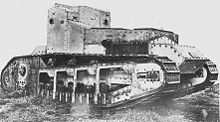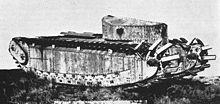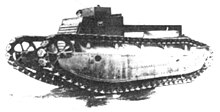Medium Mark D
| Medium Mark D | |
|---|---|

Medium Mark D Modified |
|
| General properties | |
| crew | 4th |
| length | 7.9 m |
| width | 2.5 m |
| height | 2.9 m |
| Dimensions | 20 t |
| Armor and armament | |
| Armor | 14 mm |
| Main armament | five 7.62 mm machine guns |
| agility | |
| drive | Ricardo 6 cylinder |
| Top speed | 12.7 km / h |
| Power / weight | |
| Range | 225 km |
The Medium Mark D was a medium-weight British tank from the First World War .
backgrounds
Great Britain and France saw two ways to defeat the Central Powers in World War I. Germany could be brought to its knees by a naval blockade or a decision could be sought in a ground offensive. It was decided to pursue both strategies at the same time. The sea blockade was effective, but the effects were very gradual. In 1916 an attempt was made to break through the front with an enormous excess of artillery and the mobilization of the British reserve troops that had not yet been deployed . This attempt failed because the Germans disrupted the plans with their offensive at Verdun . In the course of 1917, the Entente powers developed a new plan. By 1919 a tank power was to be built up that was so overwhelmingly strong that it could simply roll over the German front. It was then hoped (optimistically estimated) to be able to use around 30,000 tanks.
Even if the strategic goals were quite ambitious, the same could not be said of the tactical considerations of the time. Most of the generals viewed the armored forces only as an - albeit indispensable - support for the infantry. Tanks were seen as a special instrument to break through trench systems . When designing a tank, the emphasis was placed on climbing and overrun ability. The speed was secondary and the possibilities of the combination of mobility and firepower had not yet been recognized in their scope. As a result, the tanks looked more like mobile fortresses on tracked drives . Thus, the tank was as a solution to the trench warfare was developed and to the extent identified with this task so that considerations for other uses seemed to have no place. Once the trenches were breached, the tanks could be left behind and infantry and cavalry would expand this into a strategic breakthrough, making war on the move possible again. At that time there was no other choice, because the tanks were not yet suitable for war on the move due to insufficient speed, reliability and the limited range of action .
Many took this for granted, but the tacticians realized that hoping for a swift, tankless war warfare movement was an illusion. After a breakthrough, the fronts would irrevocably get stuck again after a short time, so that one had to wait until a sufficient number of armored vehicles had again gathered for a new advance. An unpleasant prospect - it could take a very long time to get to Berlin, especially because the Germans were able to holed up in the Ardennes and Vosges - both areas unsuitable for tank operations.
In May 1918 Major General JFC Fuller , the most important British tactician, wrote the now classic treatise: The Tactics of the Attack as affected by the Speed and Circuit of the Medium D Tank . In this pamphlet, better known as Plan 1919 , he described how a new tactic could be the solution to the problem. He called for fully motorized and mechanized army units to be formed that would exploit a successful breakthrough of the heavy tanks for a strategically deep penetration. Instead of laboriously pushing the enemy back over a broad front, a quick attack on a narrow section of the front was intended to paralyze its command structure and cut off the supply routes. To do this, it would have been necessary either to ignore Switzerland's neutrality or to carry out an invasion of the Belgian coast (already prepared as Operation Hush ). This new tactic, which later laid the basis for German successes at the beginning of World War II as Blitzkrieg , was immensely dependent on the existence of a completely new type of tank that had to reach a speed of at least 30 km / h. The Mark A (Whippet) , the Medium Mark B and the Medium Mark C were developments in this direction, but could not meet the requirements.

Therein, considerations for the construction of an adequate tank, the medium Mark D.
During the German spring offensive in March 1918, the inadequacies of even the heaviest British tank, the Mark V , in withstanding war of movement were painfully apparent. The 1919 plan was then well received.
It was known that Major Philip Johnson, head of the Central Workshop in France, had tried to equip a Mark IV with suspension as early as 1917 - in contrast to the French and German tanks, the British tanks were still unsprung until then. Then he had started to equip a Mark A Whippet with leaf springs , a new gearbox and a much more powerful engine. Modified in this way, the vehicle reached a speed of 50 km / h. So Johnson seemed like the right man to develop the new tank. He was promoted to Lieutenant Colonel and sent back to England in August to convert his knowledge and experience into an operational tank as quickly as possible. The speed with which the work was carried out can be seen from the fact that a pilot series of four vehicles was immediately ordered from John Fowler & Co. in Leeds . Another order for six tanks was placed with Vickers Ltd. - the first time that what would later become the most important British arms company had anything to do with tanks.
phase of development
When Johnson joined the development group at Dollis Hill , he quickly realized that it would be difficult not to disappoint the trust placed in him. He couldn't just take the Mark A, which he had modified, into production because it was not yet a full-fledged combat vehicle. The new engine robbed the turret , which was placed in the back of the Mark A, of any view. As a first solution, he decided to simply turn the construction around. The design got a vertical front right from the start. The driver stayed in his old position and was now between the stern and the turret. In order to have a reasonably decent view, he was given a mirror periscope and the roof of the porch was dropped flat towards the front.
But Johnson encountered an even more fundamental problem. The Rolls-Royce - aircraft engine , which he had used for his experiment was very strong, but spent too much gasoline, because the tanks should not only be fast but also have a long reach. Vehicle engines with the desired properties were too big and would have made the tank too heavy and too slow. The only way to compensate for this was to drastically reduce the rolling resistance of the track drive with a completely new design. A suspension was the basic requirement for this, but conventional leaf springs were very heavy.
As luck would have it, Johnson had for years been a fanatical proponent of the use of wire ropes to give constructions the necessary stability. So a new chain drive was designed in which the rollers could move freely upwards. A second row of pulleys was attached above and a wire rope was tensioned, which was held under tension at both ends by a tension spring. When the rollers moved upwards, they tensioned the wire rope and the tension springs provided the necessary counter pressure. It was a light and elegant system with the only disadvantage that the suspension travel of the castors wasn't too great. It was also very sensitive to shear forces, as the point of attack on the wire rope was very small. Small bumps were not allowed to push the caterpillar outwards, because then the rollers were pushed out of their suspension or the wire ropes were pulled from the rollers.
The "Snake Track" caterpillar
To absorb the lateral forces, Johnson designed a completely new type of track, the Snake Track . It got its name from the fact that the chain links were not connected by hinges, but by central ball joints. This allowed them to move freely in two planes and, on the one hand, to perform normal rotation and, on the other hand, a rolling movement in relation to the load-bearing element, a wire rope that ran around the rollers. This crawler track looked unusual, the chain links pointed in all directions when they ran backwards freely on the top rollers. Johnson had the drive components clamped between two wire ropes on the underside. The rollers were connected in pairs to a suspension that could rotate itself on a steel axle; each suspension carried a third wheel that pushed up against the spring rope.
The track drive looked fragile overall, but when Fowler tested it on a Mark V, it turned out to be enormously strong. The rotating chain links adjusted to the ground and the Medium D could easily reach 37 km / h with a 240 hp Armstrong-Siddeley-Puma aircraft engine .
After the war
The wooden model of the Medium Mark D was not completed until November 1918, when the war was over. Although most tank projects were terminated abruptly at this point, Major General Fuller, who had strengthened his position and had a great influence on politics, considered the further development of this tank to be essential for the development of a modern British army. He changed the requirements placed on the project. In a parallel to the development that later took place after the end of the Cold War , he saw the army's task primarily as an intervention force. The tank should therefore be more spacious and comfortable for longer periods of use and ideally also have amphibious properties. At this point the plan to build a Male version with a gun was given up, which would have taken up too much space and also caused particular difficulties to make the tank waterproof. The first prototype was delivered in June 1919. Johnson justified the different shape of the track drive with the ability of the tank to overcome slightly higher obstacles backwards. He also claimed that the primary aim of his new chain drive was to make cornering easier, as the chain links could give way to a certain extent when cornering. The first driving tests were satisfactory, but overall the vehicle was not amphibious.
Medium D *
As the first solution to this problem, the fuselage of one of the pre-production tanks that had meanwhile been built by Vickers was widened from 2.2 m to 2.56 m at the end of 1919. The aim was not only to increase the lift - it wasn't bad on the prototype because the armor at 10 mm was not too heavy - but above all to improve stability. This type, called Medium D * , still did not meet the requirements.
Medium D **
For this reason, the fuselage of a second pre-production vehicle was completely changed by Vickers in 1920 by lengthening, widening (to 2.7 m) and installing buoyancy bodies. This tank, the Medium D ** , achieved excellent driving results on a test drive near Christchurch and was able to move in the water just by running the tracks - a method many lighter armored vehicles still use today. This made it the first amphibious tank in the world.
Medium Mark DM
As early as 1919, the top command of the Army - the Army Council - decided to provide a sum of one million pounds for the purchase of 75 Medium D. Later calculations showed that 45 tanks could be purchased for this sum. The order provided for the installation of Rolls-Royce Eagle Mark VIII engines . A little later the number was reduced to 20 units, in the end only three units were built. Their type designation was Medium DM , with the "M" standing for modified . They were a slightly modified version of Medium D **. The most important visible difference was that the turret now also had a mirror periscope for a commander so that the driver could see even less. At first the command of the tank was supposed to be given by the driver, but this was rejected by General Elles , commander of the tank corps since 1917. One of the vehicles appears to have sunk during a test drive.
The first two vehicles were taken into service by the 2nd Tank Battalion on July 27, 1921. Production was then interrupted as many mechanical problems were still not resolved. In July 1922, when £ 290,000 had already been spent, the project was terminated by the Imperial General Staff .
Light infantry tank
In 1920 Johnson and his staff were demobilized. The Tank Department continued to work and tried to open up new sales markets. One possible customer was the infantry, who hoped to take over all of the armored weapons. Johnson designed a special light infantry tank , the Light Infantry Tank, which was actually nothing more than a shortened Medium D. The drive was smooth at the top and had a new type of chain link. The armor was now so thin that the total weight was just under 8 tons, so that thanks to a Hall-Scott engine with more than 100 hp, a speed of 50 km / h could be achieved. The infantry did not really need such a vehicle and so it was a prototype. In 1923 the Tank Department was closed and on August 10, 1924, any involvement of the authorities in the Medium-D project ended.
export
Tropical tanks
Johnson had already made a trip to India in December 1919 to test one of the Mark D prototypes under tropical conditions. The outside of the vehicle was fitted with asbestos insulation to protect against the heat. He then designed three different vehicles derived from the light tank for use in the colonies, the so-called Tropical Tanks from 1921. The first type had a modified, much more angular turret with hinged blinds on the front for better ventilation. The second type was greatly shortened and had two diagonally placed cylindrical towers on the back. The third type was a supply tank. None of these tanks were put into use.
America
From 1920, Johnson tried to make his revolutionary suspension known to a wider audience by equipping some truck chassis with it. This is how the Light D and the Light D * came about . One of these was shipped to the United States for testing, and the chassis received so much attention that the United States Army used it for their M1922 medium tank project. The prototype of this project is the last vehicle still in existence; all others were scrapped in 1940.






